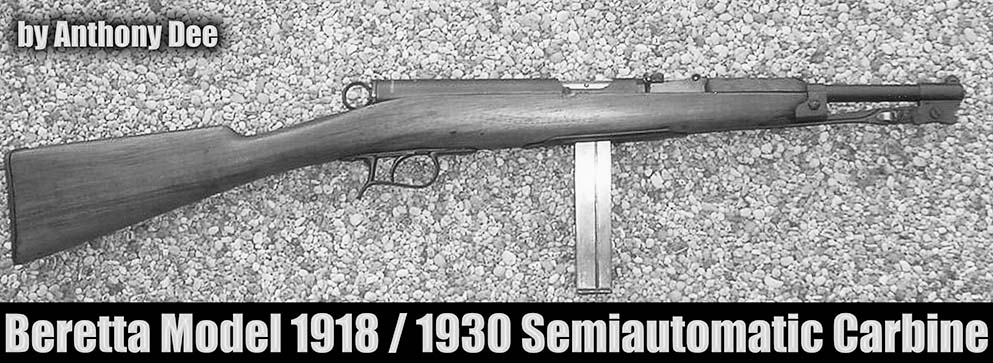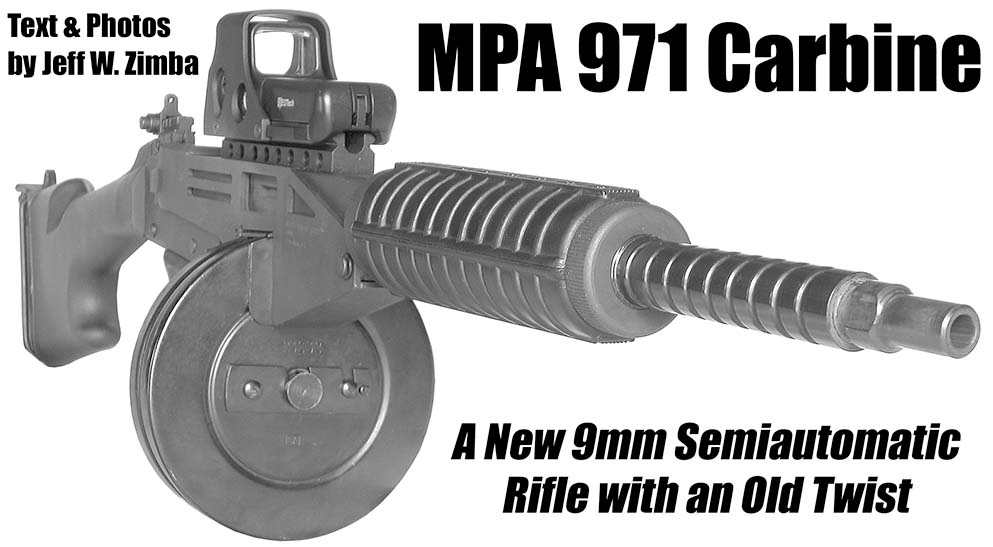
By Anthony Dee
Tullio Marengoni was said to be the John Browning of Italy. He was a very talented designer and was employed by Beretta for several years. He designed several different weapon systems for Beretta all the way up to the 1950’s. Two of his most famous designs were the Model 1918 and Model 38A Beretta submachine guns. The Model 1918 was a transformation of the famous Villar Perosa, which is said to be the first submachine gun. Both these models had magazines that were located on the top of the receivers. The second variation of the Model 1918 moved the magazine to the more conventional location of underneath the receiver providing the shooter with a clear line of sight.
The Model 1918/1930 is a semiautomatic version of the Model 1918. This model fired from a closed bolt and was straight blowback in design. The bolt has a spring loaded firing pin that is struck by an internally mounted hammer. It obtained the odd nickname (A Siringa) “The Syringe” because of the ring type cocking lever. This ring does not move once the weapon has been charged. This model also uses a double stack, single feed magazine. This magazine is a beautiful piece of craftsmanship. It is very nicely finished with a rich, deep blue, the follower is polished and even the floorplate is knurled. The magazines were manufactured in two models. One held twelve rounds and the other, twenty-five rounds. It has an open front with a loading assist button, which is very useful as the spring is very stiff.
When a loaded magazine is inserted into the weapon and the charging ring is pulled, a round will be fed into the chamber and the weapon can be fired. After the magazine has been emptied the bolt will stay open on the last shot. A unique feature of this model is that when another loaded magazine is inserted, the bolt will automatically close feeding the next round into the chamber.
Marengoni borrowed several features from Italian weapons that were already in service for this model. The bayonet is a shortened version of the Carcano Model 91 Cavalry Carbine. The “Pull Lever” bayonet locking system used on the Model 1918/1930 was also copied from a very early example of the Model 91 Carcano Cavalry Carbine that was used for a very short period of time at the turn of the century. The example shown in the photo is dated 1899. This system was abandoned for the more common “Push Button” style. The butt plate with a trapdoor for the cleaning rod is also copied from the Carcano series of carbines.
The trigger guard is pure Vetterli in design and was also used on both variations of the Model 1918 along with the VV 70 .22 caliber Training Rifle. This was a conversion that Marengoni designed and Beretta had patented in 1934 that took the old Model 70 Vetterli rifles and cut them down to carbine length. They were then converted to .22 caliber and used for training. On the Model 1918/1930, this fancy trigger guard is fitted with a sliding safety lever that will block the trigger.
Looking ahead, Marengoni used a similar type of bolt, recoil spring assembly and rear sight along with the sliding dust cover over the magazine well, and successfully incorporated them on his future designs of the Models 38A and 38/42 submachine guns.
The Model 1918/1930 was built primarily for the commercial market. Thus, the materials and workmanship were of the highest standards. It was adopted by some units of the Rome Police Department, the Italian Forestry Service and some specialized units of the Italian Army. A great many were sold to the Argentine National Police and that is where the example used in this article came from. “Policia De La Provincia De Buenos Aires” is marked on the left side of the receiver. A friend of mine in Argentina said that they were still in service until recently but were relegated mainly to guard duty. He had purchased one recently in Buenos Aires and said the condition was well worn on the outside from handling, but the internals were like new. About 50 guns were recently imported by Recon Ordnance Company of Fond du Lac, Wisconsin. Half of these were arsenal refinished, complete and in beautiful condition. The other half were not as good with some minor cracks in the wood and an incorrect bayonet mounted to it. Jerry Prasser of Recon Ordnance states that he is sold out of the refinished models but still has a few of the other ones in his inventory. This is a very rare gun and not many were manufactured. Most of them have three digit serial numbers.
Takedown for cleaning is very simple. The back of the receiver is threaded and one simply unscrews a knurled plug and pulling the “syringe” ring type cocking lever retracts the bolt from the receiver. No other field stripping is necessary.
This model is very pleasant to shoot with very low recoil. Feeding was flawless with ball ammunition but the groups were all a bit high. The one thing that impressed me was the long length of pull of 14 1/2 inches of this carbine. The average Carcano carbine is about 12 1/2 inches and the Beretta 38A is about 13 1/2 inches to the rear trigger. This is very unusual for a gun of that era, but it was nevertheless quite comfortable to shoot. Collectors of Italian military weapons are quite fortunate that this small number of rifles were imported and offered for sale, and can now own a piece of Marengoni’s genius.
Recon Ordnance Company
P.O. Box 829
Fond du Lac, WI 54936
(920) 922-1515
| This article first appeared in Small Arms Review V8N5 (February 2005) |










